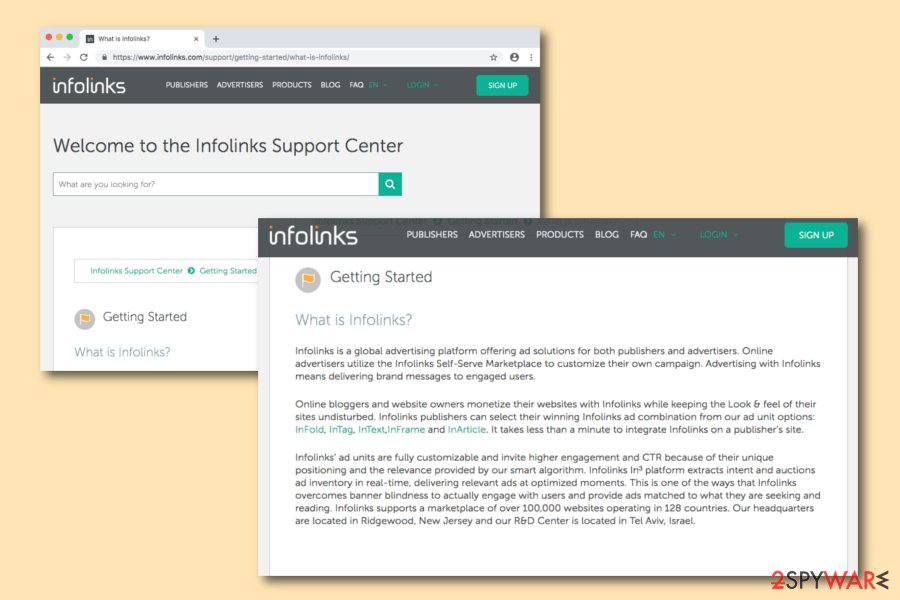Infolinks (Removal Guide) - May 2019 update
Infolinks Removal Guide
What is Infolinks?
Infolinks – an advertising network that might promote affiliate websites

Infolinks is an online advertising network, which offers various products in a form of in-text ads, banner ads and other forms of ads. It claims that the promotional content can be placed only on websites that agree to cooperate with this program. Web ads usually have a text on the ad, stating where do these ads come from (what is the provider of the ad). If you browse the Internet frequently, the question “What is InfoLinks” probably crossed your mind a couple of times already. Even though the company presents itself as a global advertising platform offering ad solutions for both publishers and advertisers, everything is not that beneficial and handy as it might seem from the first view at this sentence on their official page.
| Name | Infolinks |
|---|---|
| What it is | Advertising network |
| Activities | Advertising, redirecting |
| Causes | Ads might show up on specific pages only or be caused by an adware app |
| Ad prevention | Install and adblocking tool |
| Computer scanning software | FortectIntego can help you detect if there is any potentially unwanted content |
| Recognized as | “brought to you by Infolinks/ Infolinks ads/deals” |
You can recognize ads from this advertising network[1] easily because they might be named as “brought to you by Infolinks/ Infolinks ads/deals”. However, we are not so sure about this. Info Links claims that it is not a software, and you might encounter these ads only on particular websites, but we could hardly find any list of its affiliates.
This is kind of suspicious; moreover, we have investigated the ad network's Privacy Policy and discovered that this advertising platform promotes third-party websites,[2] plus, collects some information about your browsing activity:
“You should note that Infolinks discloses automatically collected and other aggregated non-personally-identifiable information (including without limitation, geolocation and user device identification) with interested third parties to enable and assist such third parties to target ads to websites on which our advertising products are enabled […]
When you visit any of the websites that participate in our advertising marketplace and view ads from our advertisers, we collect information, including technical information and usage information about your activities on such sites. Such information may be combined with information collected from other sources […]
Infolinks is not responsible for the content or practices of third party websites not owned or controlled by Infolinks […]
As you can see, Infolinks shares information about you with its affiliates in order to deliver targeted advertising to you. We want to warn you that some of these ads might be unsafe and lead you to suspicious third-party websites. The advertising network claims that it is not liable for any damages you may experience while visiting its partners' websites.
To make sure you avoid suspicious websites and dangers that might be hidden on them, avoid clicking on unreliable ads that pop up on your screen in an intrusive way. If you want to remove Infolinks, we have to say that it is impossible to do so because they originate from websites that you visit. At this point, we want to remind you that the ads appear only on sites that choose to publish them.

If you still do not like to see Infolinks ads and you would like to disable them, it might be possible to block Infolinks using some third-party tools meant for ad blocking. However, we strongly recommend you to read a lot of reviews and choose a trustworthy product. There are hundreds of extensions and applications that promise this feature but display even more ads instead. Be careful!
We have also noticed that many users are looking for Infolinks removal instructions for Windows 10.[3] It does not matter which operating system you use – all of them will display these ads to you because they come from web pages you enter and not from some program installed on your computer.
However, if the annoying advertisements are appearing due to an installation of a potentially unwanted program such as adware, you can proceed with Infolinks removal by eliminating the cause. Use specific tools such as FortectIntego or SpyHunter 5Combo Cleaner that will scan your entire computer system and detect the potentially unwanted content that is forcing ads to show up.

Silent distribution of ad-supported software
Even though seeing advertisements does not have to mean that adware applications are attacking your computer system and web browsers, we still would like to share some tips from DieViren.de[4] on how you can prevent installing any other adware without your knowledge:
- You need to start monitoring installation of any freeware and select only Custom or Advanced installation option in the installation setup.
- Once you do that, make sure you uncheck all checkboxes that agree with the installation of suspicious browser add-ons, extensions and plugins.
For further protection, you should think about downloading and installing a reputable anti-virus or anti-malware tool. Make sure that the software includes a feature which allows ensuring safe browsing and alerts when something potentially dangerous might be in your way. One more tip would be to keep the antivirus program always updated.
Remove adware to prevent receiving annoying advertisements
To remove any kind of adware,[5] you should first discover what is the provider of the advertisement. For example, most of the adware ads have titles above or below the ad – such as 'ads by [adware name]” or “[adware name] ads”. You should find this program in your Control Panel and delete it. You can also remove Infolinks virus by using our below provided step-by-step guide for Windows computers and web browsers.
Infolinks removal needs to be accomplished properly, otherwise rogue advertisements might keep showing up on web browser applications such as Google Chrome, Mozilla Firefox, Internet Explorer, Microsoft Edge, an Safari. If an ad-supported program has been causing these ads, you should check web browsers for adware-related signs also.
You may remove virus damage with a help of FortectIntego. SpyHunter 5Combo Cleaner and Malwarebytes are recommended to detect potentially unwanted programs and viruses with all their files and registry entries that are related to them.
Getting rid of Infolinks. Follow these steps
Uninstall from Windows
Clean your Windows computer from any rogue processes and activities. Use the below-given guide if help is needed:
Instructions for Windows 10/8 machines:
- Enter Control Panel into Windows search box and hit Enter or click on the search result.
- Under Programs, select Uninstall a program.

- From the list, find the entry of the suspicious program.
- Right-click on the application and select Uninstall.
- If User Account Control shows up, click Yes.
- Wait till uninstallation process is complete and click OK.

If you are Windows 7/XP user, proceed with the following instructions:
- Click on Windows Start > Control Panel located on the right pane (if you are Windows XP user, click on Add/Remove Programs).
- In Control Panel, select Programs > Uninstall a program.

- Pick the unwanted application by clicking on it once.
- At the top, click Uninstall/Change.
- In the confirmation prompt, pick Yes.
- Click OK once the removal process is finished.
Delete from macOS
Remove items from Applications folder:
- From the menu bar, select Go > Applications.
- In the Applications folder, look for all related entries.
- Click on the app and drag it to Trash (or right-click and pick Move to Trash)

To fully remove an unwanted app, you need to access Application Support, LaunchAgents, and LaunchDaemons folders and delete relevant files:
- Select Go > Go to Folder.
- Enter /Library/Application Support and click Go or press Enter.
- In the Application Support folder, look for any dubious entries and then delete them.
- Now enter /Library/LaunchAgents and /Library/LaunchDaemons folders the same way and terminate all the related .plist files.

Remove from Microsoft Edge
Delete unwanted extensions from MS Edge:
- Select Menu (three horizontal dots at the top-right of the browser window) and pick Extensions.
- From the list, pick the extension and click on the Gear icon.
- Click on Uninstall at the bottom.

Clear cookies and other browser data:
- Click on the Menu (three horizontal dots at the top-right of the browser window) and select Privacy & security.
- Under Clear browsing data, pick Choose what to clear.
- Select everything (apart from passwords, although you might want to include Media licenses as well, if applicable) and click on Clear.

Restore new tab and homepage settings:
- Click the menu icon and choose Settings.
- Then find On startup section.
- Click Disable if you found any suspicious domain.
Reset MS Edge if the above steps did not work:
- Press on Ctrl + Shift + Esc to open Task Manager.
- Click on More details arrow at the bottom of the window.
- Select Details tab.
- Now scroll down and locate every entry with Microsoft Edge name in it. Right-click on each of them and select End Task to stop MS Edge from running.

If this solution failed to help you, you need to use an advanced Edge reset method. Note that you need to backup your data before proceeding.
- Find the following folder on your computer: C:\\Users\\%username%\\AppData\\Local\\Packages\\Microsoft.MicrosoftEdge_8wekyb3d8bbwe.
- Press Ctrl + A on your keyboard to select all folders.
- Right-click on them and pick Delete

- Now right-click on the Start button and pick Windows PowerShell (Admin).
- When the new window opens, copy and paste the following command, and then press Enter:
Get-AppXPackage -AllUsers -Name Microsoft.MicrosoftEdge | Foreach {Add-AppxPackage -DisableDevelopmentMode -Register “$($_.InstallLocation)\\AppXManifest.xml” -Verbose

Instructions for Chromium-based Edge
Delete extensions from MS Edge (Chromium):
- Open Edge and click select Settings > Extensions.
- Delete unwanted extensions by clicking Remove.

Clear cache and site data:
- Click on Menu and go to Settings.
- Select Privacy, search and services.
- Under Clear browsing data, pick Choose what to clear.
- Under Time range, pick All time.
- Select Clear now.

Reset Chromium-based MS Edge:
- Click on Menu and select Settings.
- On the left side, pick Reset settings.
- Select Restore settings to their default values.
- Confirm with Reset.

Remove from Mozilla Firefox (FF)
Keep Firefox clean by performing the following instructing steps:
Remove dangerous extensions:
- Open Mozilla Firefox browser and click on the Menu (three horizontal lines at the top-right of the window).
- Select Add-ons.
- In here, select unwanted plugin and click Remove.

Reset the homepage:
- Click three horizontal lines at the top right corner to open the menu.
- Choose Options.
- Under Home options, enter your preferred site that will open every time you newly open the Mozilla Firefox.
Clear cookies and site data:
- Click Menu and pick Settings.
- Go to Privacy & Security section.
- Scroll down to locate Cookies and Site Data.
- Click on Clear Data…
- Select Cookies and Site Data, as well as Cached Web Content and press Clear.

Reset Mozilla Firefox
If clearing the browser as explained above did not help, reset Mozilla Firefox:
- Open Mozilla Firefox browser and click the Menu.
- Go to Help and then choose Troubleshooting Information.

- Under Give Firefox a tune up section, click on Refresh Firefox…
- Once the pop-up shows up, confirm the action by pressing on Refresh Firefox.

Remove from Google Chrome
Refresh and clean Google Chrome from adware-relates signs by using the below-given instructions:
Delete malicious extensions from Google Chrome:
- Open Google Chrome, click on the Menu (three vertical dots at the top-right corner) and select More tools > Extensions.
- In the newly opened window, you will see all the installed extensions. Uninstall all the suspicious plugins that might be related to the unwanted program by clicking Remove.

Clear cache and web data from Chrome:
- Click on Menu and pick Settings.
- Under Privacy and security, select Clear browsing data.
- Select Browsing history, Cookies and other site data, as well as Cached images and files.
- Click Clear data.

Change your homepage:
- Click menu and choose Settings.
- Look for a suspicious site in the On startup section.
- Click on Open a specific or set of pages and click on three dots to find the Remove option.
Reset Google Chrome:
If the previous methods did not help you, reset Google Chrome to eliminate all the unwanted components:
- Click on Menu and select Settings.
- In the Settings, scroll down and click Advanced.
- Scroll down and locate Reset and clean up section.
- Now click Restore settings to their original defaults.
- Confirm with Reset settings.

Delete from Safari
Remove unwanted extensions from Safari:
- Click Safari > Preferences…
- In the new window, pick Extensions.
- Select the unwanted extension and select Uninstall.

Clear cookies and other website data from Safari:
- Click Safari > Clear History…
- From the drop-down menu under Clear, pick all history.
- Confirm with Clear History.

Reset Safari if the above-mentioned steps did not help you:
- Click Safari > Preferences…
- Go to Advanced tab.
- Tick the Show Develop menu in menu bar.
- From the menu bar, click Develop, and then select Empty Caches.

After uninstalling this potentially unwanted program (PUP) and fixing each of your web browsers, we recommend you to scan your PC system with a reputable anti-spyware. This will help you to get rid of Infolinks registry traces and will also identify related parasites or possible malware infections on your computer. For that you can use our top-rated malware remover: FortectIntego, SpyHunter 5Combo Cleaner or Malwarebytes.
How to prevent from getting system tools
Protect your privacy – employ a VPN
There are several ways how to make your online time more private – you can access an incognito tab. However, there is no secret that even in this mode, you are tracked for advertising purposes. There is a way to add an extra layer of protection and create a completely anonymous web browsing practice with the help of Private Internet Access VPN. This software reroutes traffic through different servers, thus leaving your IP address and geolocation in disguise. Besides, it is based on a strict no-log policy, meaning that no data will be recorded, leaked, and available for both first and third parties. The combination of a secure web browser and Private Internet Access VPN will let you browse the Internet without a feeling of being spied or targeted by criminals.
No backups? No problem. Use a data recovery tool
If you wonder how data loss can occur, you should not look any further for answers – human errors, malware attacks, hardware failures, power cuts, natural disasters, or even simple negligence. In some cases, lost files are extremely important, and many straight out panic when such an unfortunate course of events happen. Due to this, you should always ensure that you prepare proper data backups on a regular basis.
If you were caught by surprise and did not have any backups to restore your files from, not everything is lost. Data Recovery Pro is one of the leading file recovery solutions you can find on the market – it is likely to restore even lost emails or data located on an external device.
- ^ Advertising network. Wikipedia. The Free Encyclopedia.
- ^ Sid Kemp. What is the meaning of a "third party website"?. Quora.com. Relevant questions and answers.
- ^ Windows 10. Computer Hope. Free computer help since 1998.
- ^ DieViren. DieViren. Malware Removal Guides, Cyber Security News.
- ^ Mary Landesman. What Are Adware and Spyware?. Lifewire. Tech Untangled.























